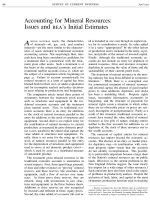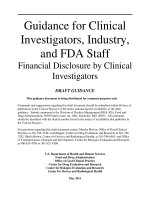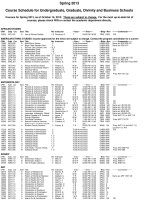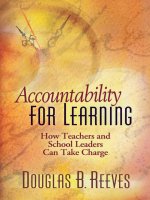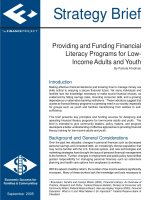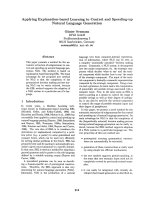Accountability for Learning: How Teachers and School Leaders Can Take Charge potx
Bạn đang xem bản rút gọn của tài liệu. Xem và tải ngay bản đầy đủ của tài liệu tại đây (1.26 MB, 169 trang )
Douglas b. Reeves
Accountability for Learning: How Teachers and School Leaders Can Take Charge
Education
$23.95 U.S.
for Learning
How Teachers and School Leaders
Can Take Charge
Accountability
VISIT US ON THE
WORLD WIDE WEB
Association for Supervision
and Curriculum Development
Alexandria, Virginia USA
Accountability. The mention of the word strikes fear in the
hearts of many teachers and school leaders, leading to confusion
and panic rather than improved student achievement. Author
Douglas B. Reeves explains how to transform accountability
from a series of destructive and demoralizing accounting drills into
a constructive decision-making process that improves teaching,
learning, and leadership. Reeves encourages educators to develop
student-centered accountability systems to capture the aspects of
teaching that test scores don’t reveal. Reeves shows how educators
can create accountability systems that enhance teacher motivation
and lead to significant improvements in student achievement and
equity, even in traditionally low-performing schools.
Accountability for Learning
explains how to build a student-
centered accountability system by examining key indicators in
teaching, leadership, curriculum, and parent and community
involvement. Reeves outlines how teachers can become leaders
in accountability by using a four-step process of observation,
reflection, synthesis, and replication of effective teaching practices.
Finally, the author discusses the role of local, state, and federal
policymakers and corrects the myths associated with No Child
Left Behind.
“As educators, we have two choices,” Reeves says. “We can rail
against the system, hoping that standards and testing are a passing
fad, or we can lead the way in a fundamental reformulation of
educational accountability.”
Accountability for Learning gives
readers the helping hand they need to lead the way to fair and
comprehensive accountability.
Douglas B. Reeves
leads the Center for Performance Assessment,
an international organization dedicated to improving student
achievement and educational equity. He is the author of 17
books, including the best-selling
Making Standards Work.
AccountforLearning_cover 12/23/03 10:39 AM Page 1
Association for Supervision and Curriculum Development
Alexandria,Virginia USA
Douglas B. Reeves
H
ow
T
eachers and
S
chool
L
eaders
C
an
T
ake
C
harge
for Learning
Accountability
AccountforLearning_title 12/23/03 10:40 AM Page 1
Association for Supervision and Curriculum Development
1703 N. Beauregard St. Alexandria, VA 22311-1714 USA
Telephone: 800-933-2723 or 703-578-9600 Fax: 703-575-5400
Web site: E-mail:
Gene R. Carter, Executive Director; Nancy Modrak, Director of Publishing; Julie Houtz,
Director of Book Editing & Production; Deborah Siegel, Project Manager; Shelley Young,
Senior Graphic Designer; Jim Beals, Typesetter; Dina Seamon, Production Specialist.
Copyright 2004 by Douglas B. Reeves. All rights reserved. No part of this publication
may be reproduced or transmitted in any form or by any means, electronic or mechani
-
cal, including photocopy, recording, or any information storage and retrieval system,
without permission from ASCD. Readers who wish to duplicate material copyrighted by
ASCD may do so for a small fee by contacting the Copyright Clearance Center (CCC), 222
Rosewood Dr., Danvers, MA 01923, USA (telephone: 978-750-8400; fax: 978-750-4470;
Web: ). ASCD has authorized the CCC to collect such fees on
its behalf. Requests to reprint rather than photocopy should be directed to ASCD’s per
-
missions office at 703-578-9600. Cover art copyright 2004 by ASCD.
ASCD publications present a variety of viewpoints. The views expressed or implied in
this book should not be interpreted as official positions of the Association.
Printed in the United States of America.
ASCD Member Book, No. FY04-4 (January 2004, PC). ASCD Member Books mail to Pre-
mium (P), Comprehensive (C), and Regular (R) members on this schedule: Jan., PC;
Feb., P; Apr., PCR; May, P; July, PC; Aug., P; Sept., PCR; Nov., PC; Dec., P.
Paperback ISBN: 0-87120-833-4 • ASCD product #104004 • List Price: $23.95
($18.95 ASCD member price, direct from ASCD only)
e-books ($23.95): netLibrary ISBN 0-87120-957-8 • ebrary 0-87120-958-6
Library of Congress Cataloging-in-Publication Data
Reeves, Douglas B., 1953-
Accountability for learning : how teachers and school leaders can take
charge / Douglas Reeves.
p. cm.
Includes bibliographical references and index.
ISBN 0-87120-833-4 (alk. paper)
1. Educational accountability United States. 2. School improvement
programs United States. I. Association for Supervision and Curriculum
Development. II. Title.
LB2806.22.R44 2004
379.1’58 dc22
2003022597
______________________________________________________
13121110090807060504 121110987654321
2
H:\!Work\!_Client_Files\ASCD\Accountability for Learning\Accountability for Learning-Final 2Printer-pages 12-23-03a.vp
Tuesday, December 23, 2003 10:13:48 AM
Color profile: Disabled
Composite Default screen
For Alex
3
H:\!Work\!_Client_Files\ASCD\Accountability for Learning\Accountability for Learning-Final 2Printer-pages 12-23-03a.vp
Tuesday, December 23, 2003 10:13:48 AM
Color profile: Disabled
Composite Default screen
4
H:\!Work\!_Client_Files\ASCD\Accountability for Learning\Accountability for Learning-Final 2Printer-pages 12-23-03a.vp
Tuesday, December 23, 2003 10:13:48 AM
Color profile: Disabled
Composite Default screen
Acknowledgments . . . . . . . . . . . . . . . . . . . . . . . . . . . . . . . . . . . . . . . . . . . . . . . . vi
Introduction . . . . . . . . . . . . . . . . . . . . . . . . . . . . . . . . . . . . . . . . . . . . . . . . . . . . . 1
1 The “A-Word”: Why People Hate Accountability and
What You Can Do About It . . . . . . . . . . . . . . . . . . . . . . . . . . . . . . . . . . . . . . . . 5
2 Accountability Essentials: Identifying and
Measuring Teaching Practices . . . . . . . . . . . . . . . . . . . . . . . . . . . . . . . . . . . . 13
3 The Accountable Teacher . . . . . . . . . . . . . . . . . . . . . . . . . . . . . . . . . . . . . . . . 28
4 Teacher Empowerment: Bottom-Up Accountability . . . . . . . . . . . . . . . . . . . . . 46
5 A View from the District . . . . . . . . . . . . . . . . . . . . . . . . . . . . . . . . . . . . . . . . . 56
6 The Policymaker’s Perspective . . . . . . . . . . . . . . . . . . . . . . . . . . . . . . . . . . . . 83
7 Putting It All Together: Standards,
Assessment, and Accountability . . . . . . . . . . . . . . . . . . . . . . . . . . . . . . . . . . 106
Appendix A: A Sample Comprehensive Accountability System . . . . . . . . . . . . . 117
Appendix B: Tools for Developing and
Implementing an Accountability System . . . . . . . . . . . . . . . . . . . . . . . . . . . . 139
Appendix C: Contact Information for State Departments
of Education and Other Organizations . . . . . . . . . . . . . . . . . . . . . . . . . . . . . 144
References . . . . . . . . . . . . . . . . . . . . . . . . . . . . . . . . . . . . . . . . . . . . . . . . . . . . 150
Index . . . . . . . . . . . . . . . . . . . . . . . . . . . . . . . . . . . . . . . . . . . . . . . . . . . . . . . . 153
About the Author . . . . . . . . . . . . . . . . . . . . . . . . . . . . . . . . . . . . . . . . . . . . . . . . 159
5
H:\!Work\!_Client_Files\ASCD\Accountability for Learning\Accountability for Learning-Final 2Printer-pages 12-23-03a.vp
Tuesday, December 23, 2003 10:13:48 AM
Color profile: Disabled
Composite Default screen
Acknowledgments
My first debt is to the thousands of teachers, leaders, board mem-
bers, writers, policymakers, and colleagues who have been willing
to engage me on the issues of educational accountability. Because
they take the time and invest the energy to challenge me with their
provocative insights and demands for practical solutions, I have
been forced to reexamine my assumptions, admit my mistakes, and
eat more than one slice of humble pie. They jolt me out of the ivory
tower and confront me daily with the realities of financial crises,
burned-out staff, and unmotivated students, parents, and even
some educators. Amid these doses of unpleasant reality, they also
provide compelling case studies of success in the most unlikely
places. Just as their candor challenges me, their stories of success
give me energy, hope, and enthusiasm.
This book marks my first collaboration with ASCD, a publisher
that has brought to educators around the world some of the most
important books of the last several decades. I am honored to be in
vi
6
H:\!Work\!_Client_Files\ASCD\Accountability for Learning\Accountability for Learning-Final 2Printer-pages 12-23-03a.vp
Tuesday, December 23, 2003 10:13:49 AM
Color profile: Disabled
Composite Default screen
their company. As always, Esmond Harmsworth of the Zachary
Shuster Harmsworth Literary Agency attended to every detail to
make this partnership work smoothly.
Footnotes and reference listings are sadly inadequate ways to
acknowledge the intellectual debt that I owe to many leading think
-
ers in this field. I have in particular been influenced by the follow
-
ing scholars, some of whom are cited in this volume, and the rest of
whom influence my writing in ways that extend far beyond a foot
-
note: Anne Bryant, Lucy McCormick Calkins, Linda Darling-
Hammond, Daniel Goleman, Audrey Kleinsasser, Robert Marzano,
Alan Moore, Mike Schmoker, and Grant Wiggins.
My colleagues at the Center for Performance Assessment are
part of every project for which I receive credit far out of proportion
to my own contribution. For this book, I am particularly indebted to
Cathy Shulkin, whose work on the appendices and references were
essential to the timely completion of the project. How she did this
while balancing a thousand details of my professional life is a mys-
tery, but I suspect it has a lot to do with intelligence, commitment,
and an extraordinary work ethic. Larry Ainsworth, Eileen Allison,
Arlana Bedard, Jan Christinson, Donna Davis, Cheryl Dunkle, Tony
Flach, Michele LePatner, Dave Nagel, Elaine Robbins-Harris, Stacy
Scott, Earl Shore, Jill Unziker-Lewis, Mike White, Steve White, Nan
Woodson, and my other colleagues at the Center have contributed
not only to my thinking about accountability but to my daily intel
-
lectual growth. Anne Fenske, the Center’s executive director, and
our colleagues deliver more than a thousand professional develop
-
ment engagements every year for hundreds of thousands of educa
-
tors and school leaders. My sincere thanks go to Sarah Abrahamson,
Greg Atkins, Ken Bingenheimer, Melissa Blunden, Nan Caldwell,
Laura Davis, Angie Hodapp, Matt Minney, and Dee Ruger.
My family loves and supports me through teaching, travel, pre
-
occupation, and exhaustion. James, Julia, Brooks, and Shelley for
-
give my absences and indulge my passion for kids, schools, and
books. Alex, to whom this book is dedicated, celebrates his 16th
birthday as my 16th book goes to press. He plays the guitar and is
more cool than is probably legal in the state of Massachusetts. At
Acknowledgments vii
7
H:\!Work\!_Client_Files\ASCD\Accountability for Learning\Accountability for Learning-Final 2Printer-pages 12-23-03a.vp
Tuesday, December 23, 2003 10:13:49 AM
Color profile: Disabled
Composite Default screen
that age I had a pocket protector with a leaking pen, black plastic
glasses, and “cool” was a climatic term. He is also a generous and
decent young man, a fabulous big brother, and a mensch of whom
his family is very proud.
Douglas Reeves
Swampscott, Massachusetts
viii ACCOUNTABILITY FOR LEARNING
8
H:\!Work\!_Client_Files\ASCD\Accountability for Learning\Accountability for Learning-Final 2Printer-pages 12-23-03a.vp
Tuesday, December 23, 2003 10:13:49 AM
Color profile: Disabled
Composite Default screen
Introduction
Teachers and educational leaders are extraordinarily busy, inun-
dated with demands for more work and better results with fewer
resources—and less time. You will decide within the next few para
-
graphs whether this book is worth your time. Let me come straight
to the point. Accountability for Learning equips teachers and lead
-
ers with the ability to transform educational accountability policies
from destructive and demoralizing accounting drills into meaning
-
ful and constructive decision making in the classroom, school, and
district. You do not need to wait for new changes in federal or state
legislation. This book is about what you can do right now to
improve learning, teaching, and leadership. Although I respect the
role that senior leaders, board members, and policymakers play in
education (see Chapter 6), the plain fact is that accountability for
learning happens in the classroom.
The traditional failures in educational accountability are not
born of a lack of knowledge or will. We know what to do, yet
decades of research and reform have failed to connect leadership
1
9
H:\!Work\!_Client_Files\ASCD\Accountability for Learning\Accountability for Learning-Final 2Printer-pages 12-23-03a.vp
Tuesday, December 23, 2003 10:13:49 AM
Color profile: Disabled
Composite Default screen
intentions to classroom reality. This “knowing-doing gap” (Pfeffer &
Sutton, 2000) is hardly unique to education. Businesses, nonprofit
organizations, health care agencies, and religious institutions all
suffer from the breach between intention and reality. The cause is
neither indifference nor indolence, yet many initiatives begin with
those assumptions. If only the presentation is persuasive enough, if
only the rewards are great enough, if only the sanctions are tough
enough, the reasoning goes, then the staff will see the light and they
will at last comply with the wishes of those giving instructions. If
sincere intentions were sufficient for success, then the landscape of
educational reform would not be littered with frustrated leaders and
policymakers who noticed that, after rendering a decision about
something that seemed momentous, absolutely nothing happened
in the classroom. The board adopted academic standards and
solemnly vowed that all children would meet them. Nothing
happened in the classroom. The superintendent announced a new
vision statement, along with core values and an organizational
mission that the entire staff would enthusiastically chant. Nothing
happened in the classroom. Millions were spent on new technol-
ogy. Nothing happened in the classroom. Staff development
programs were adopted so that teachers, like circus animals, would
be “trained” to perform new feats. Although seats were dutifully
warmed during countless trainings, nothing happened in the class
-
room. Frustrated by these organizational failures, policymakers finally
got tough and decided that accountability was the answer. School
systems and individual buildings were rated, ranked, sorted, and
humiliated. Sanctions, including job loss or reassignment, and
rewards, including thousands of dollars in bonuses, were offered as
alternating sticks and carrots, as accountability policies were reduced
to artlessly wielded blunt instruments. Yet despite the rhetoric,
threats, and promises, nothing happened in the classroom.
This book is not about achieving compliance through a combi
-
nation of threat and guile. Rather, this book begins with the funda
-
mental premise that educators and school leaders want to be
successful. Moreover, these professionals are more than a little
weary at the prospect of implementing one more program, particu
-
larly when it is placed on top of other “proven” programs within the
same time constraints. What this book provides is not an external
2ACCOUNTABILITY FOR LEARNING
10
H:\!Work\!_Client_Files\ASCD\Accountability for Learning\Accountability for Learning-Final 2Printer-pages 12-23-03a.vp
Tuesday, December 23, 2003 10:13:49 AM
Color profile: Disabled
Composite Default screen
prescription for success, but rather a method for creating your own
prescriptions based on your own data, your own observations, and
your own documentation of your most effective practices. Oscar
Wilde exaggerated only slightly when he said, “Education is an
admirable thing, but it is well to remember from time to time that
nothing that is worth knowing can be taught.” This does not mean
that I reject external research and formal study. On the contrary, I
rely heavily on the foundational work of such leading scholars as
Robert Marzano (2003) and his groundbreaking synthesis of 35
years of educational research. My colleagues at the Center for
Performance Assessment and I have tried to contribute a few
pebbles to the mountain of research on school effectiveness. But
without application in the classroom, our efforts are in vain.
Two paths lead to the effective application of research. The first
is ham-handed prescription in which the carefully nuanced ideas of
researchers become mutated into the delivery of a script, an enter-
prise that would be much more successful were it not for the incon-
venient involvement of humans. The second is a process of inquiry,
discovery, and personal application. In the first process, teachers in
exasperation say, “Just tell us what to do!” In the second process,
teachers say, “Let’s try it, test it, reflect on it, and refine it. We need
to make this work for our students and we need to recognize that
this is a school, not a factory.” Thus this book introduces “student-
centered accountability” as a constructive alternative to the data
gathering and reporting systems that now masquerade as educa
-
tional accountability.
A fair question is why teachers should be involved in account
-
ability at all. After all, isn’t educational accountability something
that is traditionally “done to” teachers? Their role, tradition has it, is
to carry out the orders of the central office. Here is the great irony:
more real accountability occurs when teachers actively participate
in the development, refinement, and reporting of accountability.
Call it the prescription paradox. Leaders engage in prescription
because they believe that it will create greater accountability. In
fact, the greater the prescription, the less real accountability that
ensues. “Sure, we’ll do it,” the teachers respond. But they imple
-
ment the prescription with neither enthusiasm nor engagement.
The students require mere nanoseconds to pick up on the
Introduction 3
11
H:\!Work\!_Client_Files\ASCD\Accountability for Learning\Accountability for Learning-Final 2Printer-pages 12-23-03a.vp
Tuesday, December 23, 2003 10:13:49 AM
Color profile: Disabled
Composite Default screen
uncertainty and cynicism of some of the most trusted adults in their
lives, the teachers. Less prescription surely suggests a risk. Without
prescription, variation will occur, as well as inconsistencies and
personal judgments. The absence of prescription will also allow
moments of discovery, enthusiasm, dedication, sharing of
successes, and relentless persistence despite extraordinary chal
-
lenges. The flip side of the prescription paradox is that with less
prescription, there is genuine accountability. There is, in a phrase,
accountability for learning.
4ACCOUNTABILITY FOR LEARNING
12
H:\!Work\!_Client_Files\ASCD\Accountability for Learning\Accountability for Learning-Final 2Printer-pages 12-23-03a.vp
Tuesday, December 23, 2003 10:13:49 AM
Color profile: Disabled
Composite Default screen
1
The “A-W ord”: Why People
Hate Accountability and What
You Can Do About It
For many educators, accountability has become a dirty word. One
superintendent even admonished me not to use “the A-word”
because it was just too emotionally volatile a term in his district. No
wonder. In virtually every school system in the world, accountabil
-
ity is little more than a litany of test scores. The prevailing presump
-
tion is that test scores, typically reported as the averages of classes,
schools, or systems, are the only way to hold teachers accountable.
Teachers know, of course, that their jobs are far more complex than
what can be measured by students’ performance on a single test,
and they understandably resent the simplistic notion that their
broad curriculum, creative energy, and attention to the needs of
individual students can be summed up with a single number.
As educators, we have two choices. We can rail against the
system, hoping that standards and testing are a passing fad, or we
can lead the way in a fundamental reformulation of educational ac
-
countability. We can wait for policymakers to develop holistic ac
-
countability plans (Reeves, 2002b), or we can be proactive in
5
13
H:\!Work\!_Client_Files\ASCD\Accountability for Learning\Accountability for Learning-Final 2Printer-pages 12-23-03a.vp
Tuesday, December 23, 2003 10:13:50 AM
Color profile: Disabled
Composite Default screen
exceeding the requirements of prevailing accountability systems.
The central thesis of this book is that if teachers embrace account
-
ability, they can profoundly influence educational policy for the
better. If teachers systematically examine their professional prac
-
tices and their impact on student achievement, the results of such
reflective analysis will finally transform educational accountability
from a destructive and unedifying mess to a constructive and
transformative force in education.
Student-Centered Accountability
In the following chapters, we explore how student-centered ac
-
countability is fundamentally different from traditional models that
rely exclusively on test scores. The terms “student-centered account-
ability” or “holistic accountability” refer to a system that includes not
only academic achievement scores, but also specific information on
curriculum, teaching practices, and leadership practices. In addition,
a student-centered system includes a balance of quantitative and
qualitative indicators—the story behind the numbers. Finally, stu-
dent-centered accountability focuses on the progress of individual
students and does not rely exclusively on averages of large groups of
students who may or may not share similar learning needs, teaching
strategies, attendance patterns, and other variables that influence test
performance. Note that student-centered accountability does not ex
-
clude test scores but places the traditional accountability reports in
context. Only when community leaders, board members, administra
-
tors, parents, and teachers understand the context of accountability
can they understand the meaning of the numbers that now adorn the
educational box scores of local newspapers.
The immediate challenge to student-centered accountability is
typically expressed by those who say, “But the public won’t listen to
anything but the scores—no one is interested in anything but the
bottom line!” Fortunately, recent events have provided a compelling
rejoinder to this logic. The corporate debacles of the early 21st cen
-
tury provide powerful evidence to support the thesis that single num
-
bers—the proverbial “bottom line”—do not tell the whole story in
business any better than they do in education. Every teacher knows
6ACCOUNTABILITY FOR LEARNING
14
H:\!Work\!_Client_Files\ASCD\Accountability for Learning\Accountability for Learning-Final 2Printer-pages 12-23-03a.vp
Tuesday, December 23, 2003 10:13:50 AM
Color profile: Disabled
Composite Default screen
that the presentation of data without a deep understanding of under
-
lying causes is analytically bankrupt. After all, Enron had great num
-
bers, and now legions of would-be retirees regret that they did not
better understand the story behind the numbers. Corporate financial
disclosures that include multiple measures and narratives as well as
numbers are likely to be more useful than the publication of box
scores. In the context of education, the “educational Enron” will
occur when a school receives short-term praise for higher test scores
and only later is it revealed that the school had an exceptionally high
dropout rate among students who might have underperformed on
the test and an exceptionally high ratio of students who were classi
-
fied as special education and were excluded from testing.
Teachers should take the lead in redefining and improving educa
-
tional accountability for three essential reasons. First, child-centered
accountability is more accurate than traditional accountability.
Second, it is more constructive. And third, it is better for motivation
of faculty and staff members.
More Accurate
To understand why child-centered accountability is more accurate
than traditional accountability, consider a medical analogy. My teen-
age daughter needs to lose 20 pounds, the doctor advises. Within a
few weeks, my daughter proudly announces, “Dad, I’ve lost 20
pounds!” Can we be satisfied that this measurement—lost weight—is
an accurate portrayal of my daughter’s health? I don’t think so. We
might have one conclusion if we take the time to learn that her
weight loss is the result of diet and exercise, and we might come to a
strikingly different conclusion if we discover that the weight loss is
due to drug abuse and an eating disorder. The “score”—the loss of 20
pounds—is the same, but the score is not an accurate reflection of
the health of the patient without the additional information we might
gain from “patient-centered” accountability. Similarly, high or low
test scores tell us little of value if we do not have the context pro
-
vided by student-centered accountability.
The “A-Word”: Why People Hate Accountability 7
15
H:\!Work\!_Client_Files\ASCD\Accountability for Learning\Accountability for Learning-Final 2Printer-pages 12-23-03a.vp
Tuesday, December 23, 2003 10:13:50 AM
Color profile: Disabled
Composite Default screen
More Constructive
Student-centered accountability is more constructive than tradi
-
tional accountability because it focuses on the improvement of
teaching and learning rather than merely rendering an evaluation
and the publication of a report. What, after all, is the fundamental
purpose of classroom assessment? Is it merely the announcement of
a grade and the classification of the student? In the most successful
classes, teachers and students understand that the purpose of
assessment is the improvement of student performance. We test so
that we know how to learn better and how to teach better. When a
test reflects inadequate performance, the result is not merely a
score, but a process of improvement. The purpose of educational
accountability is also the improvement of teaching and learning. It
is a constructive process in which successful results can be associ-
ated with specific teaching and leadership practices so that teachers
and leaders can be recognized and their successful practices can be
replicated. When an accountability system displays inadequate
results, the purpose is not humiliation and accusation, but an inten-
tional search for the underlying causes of poor achievement and the
development of specific strategies for improvement. Every teacher I
know wants students to be successful—it’s just a more fun way to
live, and student success provides the motivation for our persis-
tence in a challenging and complex profession. We have a much
higher probability of engagement in a process of continuous
improvement for ourselves and for our students when we have an
accountability system that is oriented toward constructive under
-
standing of improvement rather than one that is limited to an
announcement of a judgment about our failures.
Better for Motivation
The third reason that student-centered accountability is an impera
-
tive for today’s schools is that it is far better for the morale, motiva
-
tion, and engagement of faculty and staff members. The importance
of staff engagement cannot be overstated; the independent, volun
-
tary activities of staff members are far more related to organizational
8ACCOUNTABILITY FOR LEARNING
16
H:\!Work\!_Client_Files\ASCD\Accountability for Learning\Accountability for Learning-Final 2Printer-pages 12-23-03a.vp
Tuesday, December 23, 2003 10:13:50 AM
Color profile: Disabled
Composite Default screen
success than mere compliance with administrative mandates
(Coffman, Gonzalez Molina, & Clifton, 2002). No matter how struc
-
tured the curriculum or tightly managed the school day, the interac
-
tions between students and teachers are to a large extent the result
of the individual diligence, professionalism, and commitment of
teachers. Even the most peripatetic administrator cannot be in every
classroom all the time, supervising the instructional process. More
-
over, the most detailed accountability processes cannot ensure
high-quality instruction without high levels of teacher commitment
to and engagement in the process. High levels of teacher dissatis
-
faction with traditional accountability processes are reflected in
widespread reports of teacher stress, anxiety, and resentment,
sometimes inaccurately reported as an unwillingness of teachers to
be accountable at all. An important source of the resulting teacher
disengagement is a sense of futility and a lack of control over the ac-
countability process. In my interviews with teachers throughout the
United States, a significant theme recurs: teachers are willing to be
accountable, but they find it frustrating in the extreme to be held ac-
countable for students who do not attend school, and they are
angry that teachers and principals are the only people in the system
who are held accountable, when other participants in the child’s ed-
ucation, including parents, support staff, and central office adminis-
trators, also have important roles to play in the achievement of
educational results.
Although it is certainly not a panacea for teacher and staff dis
-
couragement, student-centered accountability can nevertheless re
-
store to teachers a degree of confidence in the fairness and meaning
of educational accountability because it includes indicators that can
be directly controlled and influenced by teachers. Moreover, be
-
cause student-centered accountability is comprehensive and in
-
cludes more than test scores, such a system makes clear the
importance of teacher quality, parent involvement, student mobil
-
ity, and a host of other factors that are ignored or obscured in tradi
-
tional accountability reports.
Student-centered accountability is not a public relations exer
-
cise, showing only the successes of schools and covering up the
failures. But student-centered accountability does provide careful
documentation of success at the classroom level, including many
The “A-Word”: Why People Hate Accountability 9
17
H:\!Work\!_Client_Files\ASCD\Accountability for Learning\Accountability for Learning-Final 2Printer-pages 12-23-03a.vp
Tuesday, December 23, 2003 10:13:50 AM
Color profile: Disabled
Composite Default screen
successes that are overlooked in a recitation of average test scores.
Because it includes a balance of quantitative and qualitative mea
-
surements, student-centered accountability will include the stories,
case studies, and vignettes that define great teaching and leader
-
ship. Moreover, the accumulation of hundreds and thousands of
these case studies provides a research base for the systematic iden
-
tification of what works in each school and district. Staff morale is
improved dramatically not through false affirmation—“Everything
is fine!” when in fact it is manifestly clear that everything is not fine.
Rather, staff morale is improved when challenges are faced honestly
and leaders recognize that many of the solutions for confronting
those challenges are in their own school and district. Great leaders
develop systematic ways to catch teachers doing things right, docu
-
ment those successes, make those successes the focal point of fac-
ulty meetings and professional development sessions, and leverage
those successes when confronting failures and challenges. These
practices are the difference between teachers who say, “We have
problems, and it’s hopeless—it’s the fault of the kids and families”
and the teachers who say, “We have problems, and our examination
of the evidence tells us that we also have solutions, and here is how
we will address each challenge ”
Teacher Leadership in Accountability
When accountability is the exclusive initiative of the legislature, the
board of education, or the superintendent, the inevitable conse
-
quence is the perception that accountability is something “done to”
students and teachers. Even in those schools and districts where
leaders pride themselves on a culture of “shared decision making” or
“site-based management,” the creation and implementation of
accountability systems is a frequent exception that undermines every
leadership initiative. This inconsistency provides ample ammunition
to the cynics who complain of the superintendent, “Sure, she talks a
good game about participative decision making, but when it came
time to design the accountability system, it was strictly top-down
management. The leader’s actions made clear that teacher opinions
didn’t matter and that our feedback was irrelevant.” To be fair, many
10 ACCOUNTABILITY FOR LEARNING
18
H:\!Work\!_Client_Files\ASCD\Accountability for Learning\Accountability for Learning-Final 2Printer-pages 12-23-03a.vp
Tuesday, December 23, 2003 10:13:50 AM
Color profile: Disabled
Composite Default screen
superintendents would respond, “But my hands are tied—I’m only
doing what the state legislature and my school board are making
me do.” There is a way out of this impasse, and that is teacher lead
-
ership in educational accountability.
When it comes to rewarding teachers, I have frequently told
school boards and superintendents, “There are no laws that prevent
you from paying teachers more than you have agreed to pay.” Con
-
versely, there are no laws that prevent teachers from being more ac
-
countable than state laws and district policies require. Perhaps your
school system is mired in the trap in which educational accountabil
-
ity is simply a set of test scores. Rather than wait for the legislature,
the school board, or the superintendent to change, why not take the
lead? Even in the most primitive accountability environment, teach
-
ers can take the lead by analyzing their own practices and testing
the relationship of those practices to student achievement. Even
when senior leaders resist student-centered accountability, teachers
can exercise their choices in professional development and assert
their prerogatives in faculty meetings, department meetings, and
grade-level meetings by focusing on their impact on student
achievement. Teachers can produce newsletters and accountability
reports that tell the story behind the numbers and communicate
with parents and other stakeholders about their challenges and suc-
cess stories. Teachers can produce “best practices” books that
frankly acknowledge their mistakes and highlight their successes,
providing guidance for new teachers and veterans alike. Teachers
can, in a word, embrace accountability. They can approach their
leaders, their school board, and the public, saying, “We are going to
be more accountable than you asked us to be, and we are going to
do accountability in a way that is constructive and student-centered.
We don’t have to do this by virtue of any law or policy, but we are
choosing to do so because it is the right thing to do and it is in the
best interests of the children we serve.”
If this vision of accountability sounds appealing, then read the
following chapters to learn how to do it. If it sounds impossible,
then read the following chapters to learn how your colleagues
across the country have already done it. If it sounds complicated,
then read the following chapters to discover some tools that you
can use immediately to demystify the complexities of assessments
The “A-Word”: Why People Hate Accountability 11
19
H:\!Work\!_Client_Files\ASCD\Accountability for Learning\Accountability for Learning-Final 2Printer-pages 12-23-03a.vp
Tuesday, December 23, 2003 10:13:50 AM
Color profile: Disabled
Composite Default screen
and accountability. Although student-centered accountability is not
easy, it is infinitely more rewarding than the prevailing model of test
scores, threats, intimidation, and poisoned morale. The effort you
invest in this process will be rewarded in better student achieve
-
ment, improved professional practices, greater personal satisfac
-
tion, and more fun every day in the world’s most important job.
12 ACCOUNTABILITY FOR LEARNING
20
H:\!Work\!_Client_Files\ASCD\Accountability for Learning\Accountability for Learning-Final 2Printer-pages 12-23-03a.vp
Tuesday, December 23, 2003 10:13:50 AM
Color profile: Disabled
Composite Default screen
2
Accountability Essentials
dentifying and Measuring
Teaching Practices
Mrs. Hadzel was near tears as she looked at the article on the front
page of the local newspaper. It listed, for all the world to see, the
recent test scores of every classroom in every school in the commu
-
nity. Steadfastly refusing to bend to the forces of time and declining
eyesight, she eschewed bifocals. But for this article, the small print in
the newspaper required her to resort to a magnifying glass. There she
was: “4H Stanley 82 Sat.” The reader was supposed to discern that this
meant that the students in her 4th grade class at Stanley Elementary
School—denoted “H” because of the first letter of her last name—had
scored an average of 82 on their composite scores on the most recent
state examination and therefore were deemed “satisfactory.”
“All that work, all that progress, all that love, and this is what
people think I am—4H Stanley 82 Sat,” she thought. “What about
the parent meetings? What about the hours before and after school
with Mikhail who didn’t speak English when he came here but took
the test anyway and scored in the 70s? What about Lamar who was
developmentally delayed and, with some extra time, finished the
13
21
H:\!Work\!_Client_Files\ASCD\Accountability for Learning\Accountability for Learning-Final 2Printer-pages 12-23-03a.vp
Tuesday, December 23, 2003 10:13:51 AM
Color profile: Disabled
Composite Default screen
entire test and beamed with pride as he put down his pencil, ex
-
hausted, after four hours and achieved a score of 36?” Mrs. Hadzel’s
pride in Lamar was particularly poignant because her own disabled
daughter had been artfully excluded from the state test by a team of
teachers and administrators who feared that she would bring down
the school’s test scores.
Why do we reduce the art and science of teaching to superficial
numbers? The easy response is to blame a cabal of politicians and
administrators or to expand the conspiracy theory to include big
business and the entertainment industry. But the role of victim is
unworthy of the teaching profession, and we must do better. Why
has accountability been reduced to a litany of test scores? Because
we have failed to tell our story. Because we have, in fact, resisted
many attempts to measure classroom activities, professional teach-
ing strategies, curriculum implementation, and building-based lead-
ership decisions. We insisted that “teaching is an art, not a science”
and that we were therefore impervious to scrutiny and accurate
measurement. That gave our critics the easy choice of reducing the
Mrs. Hadzels of the world to “4H Stanley 82 Sat.”
It need not be this way. Educational accountability can be holis-
tic rather than fragmentary. Accountability can tell the story of the
students, teachers, administrators, parents, and partnerships that
make their schools no less than places of wonder. This is not a wist
-
ful hope from the ivory tower, but a conclusion reached after direct
observation of teachers committed to making accountability more
than test scores.
Teachers across the nation have already begun to create new
accountability systems that reflect not only the effects of their work,
but also the causes of student achievement. One would think that
their efforts would be welcomed, but in fact they have had to over
-
come a torrent of opposition from those who, while complaining
about tests, also resist the use of any other accountability mechanism.
The critics of holistic accountability feed into the public education
critics who revel in the rhetoric that states that educators are unac
-
countable and intransigent. Only test scores, the critics claim, will
whip the lazy teachers into shape. By such logic, the critics would
conduct blood pressure tests for patients with hypertension but pay
14 ACCOUNTABILITY FOR LEARNING
22
H:\!Work\!_Client_Files\ASCD\Accountability for Learning\Accountability for Learning-Final 2Printer-pages 12-23-03a.vp
Tuesday, December 23, 2003 10:13:51 AM
Color profile: Disabled
Composite Default screen
no attention to diet, exercise, pharmaceuticals, or hereditary
diseases—all they would care about is the blood pressure test
score. That is hardly an illuminating exercise for the patient, but if
hypertensive patients were as attractive targets as public education,
then few people would find such silly and illogical analysis annoy
-
ing. If educators are to make the case that accountability is more
than test scores, then they must embrace, rather than resist,
accountability as a constructive force. Educators must tell their
story, including the extraordinary efforts they make on behalf of
students and parents every day. This will require a combination of a
quantitative measurement of their daily activities and a qualitative
description of their intensity, intellect, and commitment. In other
words, they must embrace holistic accountability.
Components of Holistic Accountability
I have described the central thesis that “accountability is more than
test scores” in two other books: Accountability in Action: A Blueprint
for Learning Organizations (Reeves, 2000a) and Holistic Account-
ability: Serving Students, Schools, and Community (Reeves, 2002b).
Accountability in Action provides a step-by-step method for a team
of administrators and teachers to create a comprehensive district ac
-
countability system. Holistic Accountability is a much shorter intro
-
duction to the nature of holistic accountability and is appropriate as
an overview for board members, legislators, and senior administra
-
tors. How is the book you are now reading different? This book fo
-
cuses on the needs of teachers. It does not depend upon new
accountability policies by state legislators or the local board of educa
-
tion. Rather, it focuses on steps that can be taken at the building and
classroom levels to transform educational accountability from a de
-
structive force into a constructive approach to the improvement of
teaching and learning. Even in states and school systems that remain
mired in the myth that educational accountability is nothing more
than a set of test scores, effective teachers can, on their own initiative,
begin to reframe accountability so that they provide essential context
for those scores. This context includes the rich description of
Accountability Essentials 15
23
H:\!Work\!_Client_Files\ASCD\Accountability for Learning\Accountability for Learning-Final 2Printer-pages 12-23-03a.vp
Tuesday, December 23, 2003 10:13:51 AM
Color profile: Disabled
Composite Default screen
teaching, curriculum, student actions, and leadership decisions. This
context is what makes accountability make sense.
The Antecedents of Excellence
There are two types of educators reading this book. An educator in
the first group might say, “I know I’m good and I know that my stu
-
dents have high achievement. They always look great when the dis
-
trict and state accountability scores come out, so why should I
bother doing any additional work on accountability? This ‘holistic
accountability’ stuff just sounds like more paperwork to me, and I’d
rather spend that time interacting with my students.” An educator in
the second group might lament, “I’m exhausted—no matter how
hard I work and no matter what I do, there is little relationship be-
tween the effort I put into my profession and the results that the
newspaper publishes about our test scores. This is little wonder—
more than 40 percent of the kids who took the state test in the
spring were not here in the fall, and I have colleagues for whom
mobility is an even bigger problem—80 percent of the kids who
take the state test were not with the teacher all year long either be-
cause of mobility or because of excessive absences. How can those
scores reflect our abilities as professional educators?”
Both of these groups of educators deserve a thoughtful response.
To the first group I would say that if the present accountability system
is working well for them, they should be exceptionally happy and
appreciate their good fortune. It is rare indeed for a teacher to say
that the local newspaper, not to mention the state or district account
-
ability system, reflects the full extent of their efforts. Upon closer ex
-
amination, even the most sanguine teacher will usually acknowledge
those golden moments in the classroom when a connection is made
with a student, the proficient student makes a leap to exceptional
work, or the discouraged student becomes engaged. These mo
-
ments, the ones that define our careers years after the students have
moved along, are rarely evident in the sterile numbers that masquer
-
ade as accountability. Thus even the highly recognized teacher
whose students’ scores are high and who has not yet felt the political
pressures of accountability should find a systematic emphasis on the
16 ACCOUNTABILITY FOR LEARNING
24
H:\!Work\!_Client_Files\ASCD\Accountability for Learning\Accountability for Learning-Final 2Printer-pages 12-23-03a.vp
Tuesday, December 23, 2003 10:13:51 AM
Color profile: Disabled
Composite Default screen
